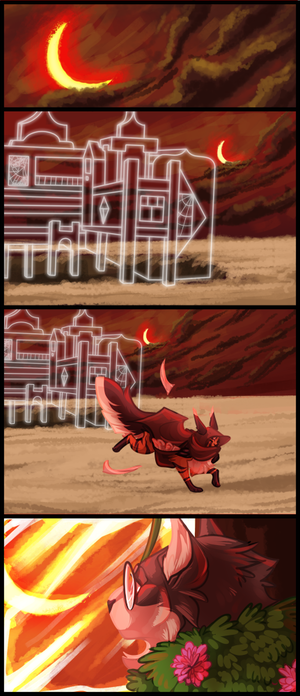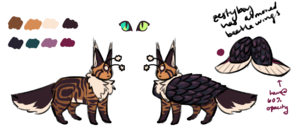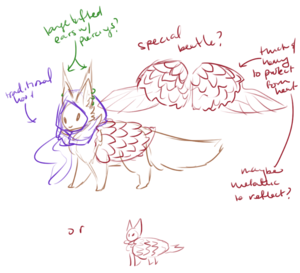Desert Mothcats
Desert Mothcats are a type of Mothcat breed.
Flare Ring

The flare ring, also known as the Phoenix's Wedding, is a natural phenomenon that occurs when the moon does not fully cover the sun during a solar eclipse. This event is significant in certain cultures of the Mothcats world, particularly in the regions near the equator. In the Xandeera Desert, solar eclipses signify the start of a Mothcat's rite of passage. During the eclipse, Xandeeran (Desert) Mothcats between the ages of 1-2 years venture into the outside world in search of knowledge, leaving no stone unturned for the duration of their journey. While any solar eclipse is acceptable for Desert Mothcats to begin their journeys, it is customary among Xandeerans to wait for the flare ring, which is believed to be a symbol of good fortune. These journeys can last anywhere from a few months to several years, and Desert Mothcats will return home on the nights of a lunar eclipse, signifying the ends to their journey.
Xandeeran/Desert Mothcats
Mothcats who have adapted to the harsh environment of the desert are called Xandeeran Mothcats (or more simply, Desert Mothcats). They have long tufted ears and thick scaly wings, which protect the Mothcats from the extreme temperatures of the desert. These specialized wings typically come in the form of beetle or "feather" wings. Beetle wings are more commonly found among Mothcats in the northern desert, while feather wings are seen more often in the southern desert. While Desert Mothcats are able to use magic to fly much like other Mothcats, their flying abilities are limited due to the weight of their wings which are more suited for physical protection than flight.Desert Mothcats, as a society, are scholars who live in large holes located in the Xandeera Desert. Their capital is centered around the Library of Xandeera, a grand library that contains knowledge accumulated by many generations of scholars. Each city has a spiral path that leads Mothcats up and down the holes, with individual tunnels leading to homes and storage space. The sandstone walls are decorated with stories of their beginning, acting as a constant reminder for why the Desert Mothcats were forced to lead lives underground.
It is said that the original Desert Mothcats were wealthy merchants who grew complacent with the riches they obtained. They had no motivation to work and corruption was rampant among their society. As punishment, the Mothlion of Earth and Stone sank their cities and buried their riches, forming the holes that the Mothcats live in today. "Dig," the Mothlion said, "if you love your money and jewels so much and if they are truly that valuable to you, then dig. Work to get them back."
Desperate to regain their fortune, the Mothcats spent many years digging as instructed by the Mothlion. Enough time passed that they no longer remembered what the outside world was like. The only interaction they had with it were those lucky times when less fortunate animals fell to their demise, feeding the hungry cats whose food stores were long since depleted. When the Mothcats finally unearthed their long lost treasure, the riches that once shined so brightly to them no longer had that same glow.
With no purpose left in the holes, the Mothcats decided to build a new society. They forged a path to the surface, a distance too far for their wings to carry, and learned as much as they could in order to catch up on the outside world. Dedicated Mothcats wrote scrolls and books to document their adventures so that they could share the wonders with those down below who were too weak, old, or young to travel to the surface. This act eventually led to the construction of the Great Library in the heart of the Xandeera Desert, where society was influenced by how many academic contributions one made rather than how much money they owned. The gold and jewels left over from their former days were recycled to make earrings, signifying the amount and degree of academic achievements individual Mothcats accomplished.
Rite of Passage

All Desert Mothcats have to go through a rite of passage before they are acknowledged by society. When they set out to the world, Mothcats are expected to research unknown topics and write books based on what they discovered. The rite of passage is complete when the Mothcat returns to their home and presents their work to the leading scholars of their city. If the work is accepted, the Mothcat earns their first earring and is given permission to travel as they please, whether it is to do further research or live elsewhere - that is up to them.
Mothcats who fail their rite of passage are given one extra chance to contribute to society. During the next solar eclipse, they are required to go out and journey again. If they fail a second time, then those particular Mothcats become the scum of society who are forced to do manual labor or banished from the city altogether.
Mothcats who are not confident enough in their work or unmotivated usually abandon their quest and never return to their hometowns. After 5 years of no return, it is almost always certain that a Mothcat gave up, and the families they left behind will sometimes perform a ceremonial funeral in honor of their lost loved one.
